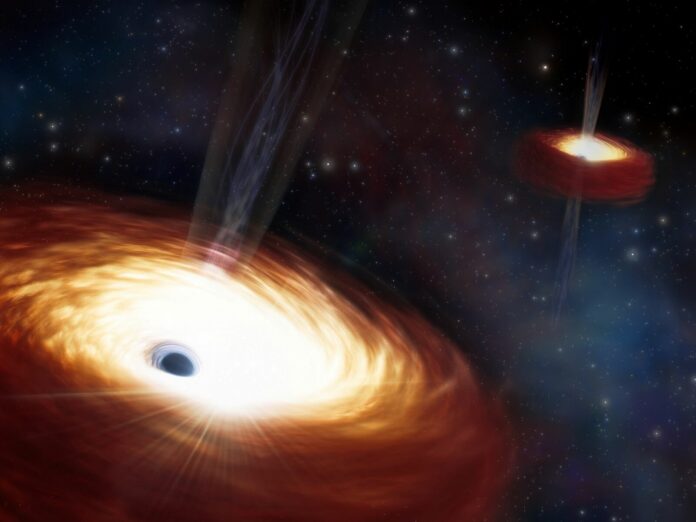Using data from the Gemini North telescope in Hawai’i, a team of astronomers has measured the heaviest pair of supermassive black holes ever found. Despite being already predicted, the merging of two black holes has never been observed. This discovery offers insights into the unlikelyness of such events in the universe.
Two merging black holes can eventually form a binary pair. It is theorized that these binaries will merge eventually, but this has never been observed. Whether such an event is possible has been a discussion amongst astronomers for decades. A new study offers insight into this question.
The team used data from the Gemini North telescope in Hawai’i, one-half of the International Gemini Observatory operated by NSF’s NOIRLab. They analyzed a supermassive black hole binary located within the elliptical galaxy B2 0402+379.
This is the only pair of supermassive black holes that scientists have ever been able to see separately in enough detail. They’re close to each other, just 24 light-years apart, the smallest distance ever measured directly for such objects. This closeness suggests that they should have merged long ago, but surprisingly, they’ve been stuck at this distance for over three billion years.
The next step was to understand the dynamics of the system. They looked through archival data from Gemini North’s Gemini Multi-Object Spectrograph (GMOS). Through this, they could determine the speed of the stars within the vicinity of the black holes.
The team found that the combined mass of the two black holes is a massive 28 billion times that of the Sun, making them the heaviest binary black hole ever measured. This vast mass gives us essential information about how the binary system formed and the history of the galaxy it’s in. It also supports the idea that the group of black holes is a crucial factor in why they haven’t merged yet.
Martin Still, NSF program director for the International Gemini Observatory, said, “The data archive serving the International Gemini Observatory holds a gold mine of untapped scientific discovery. Mass measurements for this extreme supermassive binary black hole are an awe-inspiring example of the potential impact of new research exploring that rich archive.”
Understanding the formation of this binary black hole system can help us predict if. When it will eventually merge, several clues suggest that these black holes formed through merging multiple galaxies.
The galaxy where these black holes are found, B2 0402+379, is called a ‘fossil cluster.’ This means it results from many galaxies merging into one giant universe. Also, having two supermassive black holes, especially ones with such a large combined mass, suggests they came from merging smaller black holes from different galaxies.
After galaxies merge, the supermassive black holes start passing by each other, gradually getting closer as they settle into a bound orbit. During this, they transfer energy to the surrounding stars, which slows them down and brings them closer together. When in close proximity- just a few light-years apart, gravitational radiation takes over, and they finally merge. This process has been seen with smaller black holes but never before with supermassive ones.
Considering the huge mass of this binary system, the team believes that a massive number of stars would have been needed to slow down their orbit to this extent. As they passed each other, the black holes likely flung out most of the matter around them, leaving the galaxy’s core with very few stars and gas. With more material to slow them down further, their merger has continued in its final stages.
Romani said, “Normally, it seems that galaxies with lighter black hole pairs have enough stars and mass to drive the two together quickly. Since this pair is so heavy, it required lots of stars and gas to get the job done. But the binary has scoured the central galaxy of such matter, leaving it stalled and accessible for our study.”
Tirth Surti, Stanford undergraduate and the lead author on the paper said, “We’re looking forward to follow-up investigations of B2 0402+379’s core where we’ll look at how much gas is present. This should give us more insight into whether the supermassive black holes can eventually merge or if they will stay stranded as a binary.”
Journal Reference:
- Tirth Surti et al. The Central Kinematics and Black Hole Mass of 4C+37.11. The Astrophysical Journal. DOI 10.3847/1538-4357/ad14fa
